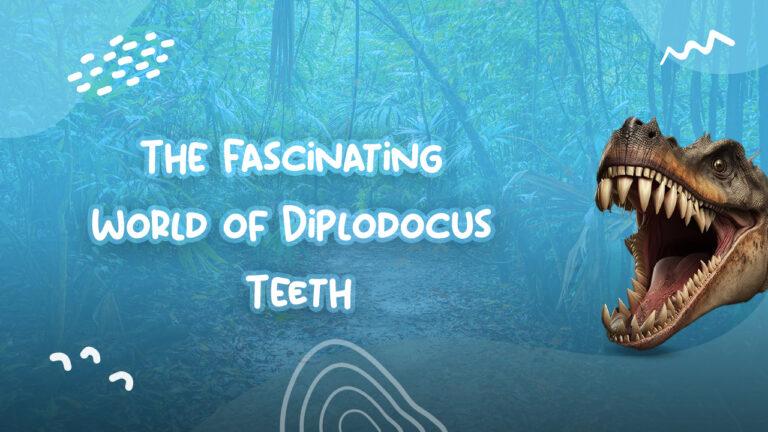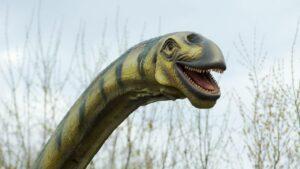The Fascinating World of Diplodocus Teeth

Delving into the world of diplodocus teeth provides us with a fascinating glimpse into the life of one of the most famous dinosaurs that ever roamed the earth. These colossal creatures captured our imaginations and have played a pivotal role in shaping our understanding of the prehistoric world
. As seemingly minute aspects of their biology, the teeth of these dinosaurs offer critical information about their diet, habitats, and overall adaptation to their environment. In this blog post, we will explore the unique features of diplodocus teeth and what they reveal to us about the lives of these magnificent beasts.
Diplodocus Teeth Structure
Diplodocus teeth are quite unique in their structure when compared to other dinosaurs. They were long, slender, and peg-like, which is different from the more robust and larger-shaped teeth found in many other herbivorous dinosaurs.
A single Diplodocus could have as many as 128 teeth, despite their relatively small size compared to the overall size of the animal. These teeth were primarily located at the front of the jaws, leaving the majority of the jaw bone area toothless.
Unique Tooth Structure and Feeding Adaptations
Unlike other sauropods, the diplodocus had an interesting tooth structure. Its teeth were peg-like, with two rows of teeth on each side of its upper jawbone.
They were very unusual in that they were all uniform in size, unlike other species which could have varying sizes of teeth based on their age or diet. The diplodocus also lacked any sort of serrated edges, which many other herbivorous dinosaurs had.
Evolutionary Adaptations of Diplodocus Teeth
The unique shape and arrangement of diplodocus teeth are a direct result of evolutionary adaptations to their preferred diet. Diplodocus was a herbivore, mostly feeding on low-growing vegetation, such as ferns and horsetails that were abundant in the Late Jurassic period.
Since their long necks and small heads made it difficult to generate a strong bite, they could not chew the plant material thoroughly. Instead, their teeth were more suited for stripping vegetation off plants rather than grinding it down.
The Significance of the Diplodocus Teeth Structure
The unique tooth structure of the diplodocus is believed to have been an adaptation for its diet–it primarily ate ferns and cycads. These plants are extremely tough and fibrous.
It’s thought that the lack of serrated edges allowed Diplodocus teeth to be consumed more easily by breaking them down into smaller pieces rather than trying to rip through them as some carnivorous dinosaurs would do. This adaptation likely gave the Diplodocus a distinct advantage compared to other sauropods when it came time to feed.
Tooth Replenishment in Diplodocus
Another fascinating aspect of diplodocus teeth is their ability to continually grow and be replaced throughout the animal’s lifetime. When a tooth was lost or worn out, a new one would replace it, keeping a constant cycle of growth and replenishment.
It is estimated that a new tooth developed every 35 days in a diplodocus, ensuring that they always had a functional set of teeth to feed efficiently. This rapid tooth replacement is an essential adaptation to the diplodocus’ feeding habits, given the amount of wear and tear their teeth experienced throughout their lives
Dietary Habits
The study of Diplodocus teeth has provided invaluable insight into their dietary habits. Their unique dental structure allowed for a detailed analysis of the wear patterns, leading experts to believe that these giants most likely fed on low-lying vegetation like ferns and horsetail plants.
This would have been a vital adaptation due to the constraints of holding up their massive heads and long necks. Understanding their dietary preferences has granted a greater appreciation for how these behemoths managed to sustain themselves throughout their lives.
Diplodocus Teeth and Implications on Feeding Behavior
The unique features of diplodocus teeth have provided paleontologists with valuable insights into the feeding behavior of these extinct giants. The shape and structure of their teeth suggest that they were not adapted for aggressive chewing or cutting through the tough plant material.
Instead, they likely used a raking motion to strip leaves and other soft vegetation from plants. This interpretation of their feeding habits is supported by the relatively small size of their heads, which would not provide the muscular power needed for more rigorous chewing.
Insights into Diplodocus Ecology
The study of diplodocus teeth also sheds light on the overall ecology of the environment in which they lived. Their preferred diet of low-growing vegetation indicates that they likely inhabited open habitats with abundant ferns and horsetails, rather than dense forests.
Furthermore, the rapid growth and replacement rate of their teeth suggest that they had access to large quantities of food to support their massive size. This information is essential for paleontologists seeking to reconstruct the ecological dynamics of the Late Jurassic period.
What We Can Learn from Diplodocuses Today
Studying how species adapt to their environment can provide us with valuable insight into our own lives today. Just like how different species have adapted over time so that they can survive and thrive in their respective environments.
We as human beings must also make sure that we are adapting to our changing environment if we want to continue living healthy and sustainable lives. By studying animals such as the diplodocus with its unique tooth structure, we can gain new perspectives on how best to go about doing this.
Diplodocus Teeth in the Bigger Picture
Research into Diplodocus teeth has provided scientists with invaluable information on not just their feeding habits, but also the broader ecosystems and climate of that era.
Comparing these dinosaur’s dental structures and details with modern-day analogues helps researchers understand the types of plants that existed during the Diplodocus’ reign on Earth. This has helped to paint a more accurate and vivid picture of the world that these awe-inspiring animals inhabited.
Conclusion
Diplodocus teeth may seem like a small detail in the larger picture of these incredible dinosaurs, but their unique features offer invaluable insights into their biology and the world they inhabited. Comprehending their evolutionary adaptations helps us gain a deeper appreciation for the fascinating lives of these prehistoric giants.
Also for the intricate balance of ecosystems during the Late Jurassic period. With continued research into the captivating world of dinosaur teeth, we inch closer to understanding the immense complexity and beauty of these creatures that once ruled our planet.
Want more interesting blog about dinosaurs? check out Dinosaurs Of Antartica.

Top posts
related articles
Discover The Top 10 Longest Dinosaur Names
Dinosaurs, the ancient giants that once roamed the Earth, continue to capture our imagination. While
Discover the Amazing Dinosaur with 500 Teeth
Dinosaurs have always fascinated us with their colossal size, unique features, and intriguing mysteries. One
Acheroraptor – Tiny But Fierce Dinosaur
The dinosaur world is undoubtedly fascinating, and the relative discovery of the Acheroraptor is no
Amazing Cryolophosaurus- An Epic Tale
Cryolophosaurus, also known as the ‘Antarctic King’, was a fierce and fascinating dinosaur that existed
Discover Torosaurus And Its Mysterious Identity
Dinosaurs don’t exist anymore, but their fossils still fascinate us. Paleontologists scour the earth to
Corythosaurus–Exploring Its Wondrous World
The world of dinosaurs never stops fantastic us. From the huge T-rex to the tiny



